Developing a Dynamic Supervision Mechanism to Improve Construction Safety Investment Supervision Efficiency in China: Theoretical Simulation of Evolutionary Game Process
Abstract
1. Introduction
2. Literature Review
2.1. Safety Investment in the Construction Industry
2.2. Government Safety Supervision in the Construction Industry
3. Research Methodology
3.1. Overall Research Framework
3.2. Safety Investment Information System and Dynamic Supervision Mechanism
3.2.1. Safety Investment Information System
- (1)
- Participants and their responsibilities
- (2)
- Management process
3.2.2. Dynamic Supervision Mechanism Based on the Safety Investment Information System
3.3. Multiplayer Evolutionary Game Model
3.3.1. Game Relationship Description and Assumptions
3.3.2. Parameters and Payoff Matrix
- Static supervision mechanism
- Dynamic supervision mechanism
3.4. System Dynamics Simulation and Validation
3.4.1. System Dynamics Model Settings
3.4.2. Validation
4. Results
4.1. Replicator Dynamics of the Multiple-Player Evolutionary Game Model
4.2. Stock and Flow Diagram of SD
4.3. Simulation Results Analysis
4.3.1. Evolutionary Game Player’s Strategy Choices under Different Penalty Control Strategies
4.3.2. Evolutionary Stable Equilibrium Analysis
4.3.3. Optimization of the Dynamic Penalty Control Strategy
5. Discussion
6. Conclusions
- (1)
- The proposed safety investment information system could contribute to eliminating the information gap between the government and contractors and facilitate the transition of the safety investment supervision mode from static to dynamic.
- (2)
- Under the static penalty control strategy, the three stakeholders’ strategy selections fluctuate periodically and an ESS does not occur in the evolutionary game play.
- (3)
- When using the dynamic penalty control strategy that correlates penalties with contractors’ unlawful behavior probability, the fluctuation of the stakeholders’ strategy choices can be effectively suppressed, and the game reaches an ESS at approximately 10-15 years after the game starts.
- (4)
- Under the optimized scenario of the dynamic penalty control strategy, which further correlates penalties with the government supervision probability, not only is the fluctuation of stakeholders’ strategy choices effectively suppressed but the game process can also reach an ideal ESS in advance. In this scenario, the contractors could nearly choose to make a sufficient safety investment as their optimal strategy approximately 1–2 years after the game starts.
- (5)
- Under the dynamic supervision mechanism based on the safety investment information system, as the probability of contractor making sufficient safety investment and the probability of government supervision can reach a stable ideal value in the game process, the dynamic supervision mechanism’s effectiveness in improving supervision efficiency is validated.
Author Contributions
Funding
Institutional Review Board Statement
Informed Consent Statement
Acknowledgments
Conflicts of Interest
Appendix A
Appendix B
- (1)
- “contractor (1) making sufficient safety investment fitness (Uy1)” = “Normal revenue of contractor (1) from regular safety production (R1)”—“Standard safety investment required in laws and regulations in contractor (1)’s program (S1)”
- (2)
- “contractor (1) not making sufficient safety investment fitness (U1−y1)” = “probability of contractor (2) making sufficient safety investment (y2)” * (“Normal revenue of contractor (1) from regular safety production (R1)”—“Contractor (1)’s actual safety investment (S1’)”—“government supervision ratio (x)” * “Contractor (1)’s penalty (P1)”) + (1-”probability of contractor (2) making sufficient safety investment (y2)”) * (“Normal revenue of contractor (1) from regular safety production (R1)”—“Contractor (1)’s actual safety investment (S1’)”—“government supervision ratio (x)” * “Contractor’s penalty when both contractors do not make sufficient safety investment (P)”)
- (3)
- “Contractor (1)’s penalty (P1)” = “penalty coefficient (k)” * (“Standard safety investment required in laws and regulations in contractor (1)’s program (S1)”—“Contractor (1)’s actual safety investment (S1′)”)
- (4)
- “Contractor’s penalty when both contractors do not make sufficient safety investment (P)” = “Contractor (2)’s penalty (P2)” + “Contractor (1)’s penalty (P1)”
- (5)
- “fitness difference between contractor (1) making sufficient safety investment and not making sufficient safety investment (Uy1 − U1−y1)” = “contractor (1) making sufficient safety investment fitness (Uy1)”—“contractor (1) not making sufficient safety investment fitness (U1−y1)”
- (6)
- “changing rate of contractor (1) choosing making sufficient safety investment (F (y1, y2, x))” = “probability of contractor (1) making sufficient safety investment (y1)” * (1-”probability of contractor (1) making sufficient safety investment (y1)”) * “fitness difference between contractor (1) making sufficient safety investment and not making sufficient safety investment (Uy1 − U1−y1)”
- (7)
- “contractor (2) making sufficient safety investment fitness (Uy2)” = “Normal revenue of contractor (2) from regular safety production (R2)”—“Standard safety investment required in laws and regulations in contractor (2)’s program (S2)”
- (8)
- “contractor (2) not making sufficient safety investment fitness (U1−y2)” = “probability of contractor (1) making sufficient safety investment (y1)” * (“Normal revenue of contractor (2) from regular safety production (R2)”—“Contractor (2)’s actual safety investment (S2’)”—“government supervision ratio (x)” * “Contractor (2)’s penalty (P2)”) + (1-”probability of contractor (1) making sufficient safety investment (y1)”) * (“Normal revenue of contractor (2) from regular safety production (R2)”—“Contractor (2)’s actual safety investment (S2’)”—“government supervision ratio (x)” * “Contractor’s penalty when both contractors do not make sufficient safety investment (P)”)
- (9)
- “Contractor (2)’s penalty (P2)” = “penalty coefficient (k)” * (“Standard safety investment required in laws and regulations in contractor (2)’s program (S2)”—“Contractor (2)’s actual safety investment (S2′)”)
- (10)
- “Contractor’s penalty when both contractors do not make sufficient safety investment (P)” = “Contractor (2)’s penalty (P2)” + “Contractor (1)’s penalty (P1)”
- (11)
- “fitness difference between contractor (2) making sufficient safety investment and not making sufficient safety investment (Uy2 − U1−y2)” = “contractor (2) making sufficient safety investment fitness (Uy2)”—“contractor (2) not making sufficient safety investment fitness (U1-y2)”
- (12)
- “changing rate of contractor (2) choosing making sufficient safety investment (G (y1, y2, x))” = “probability of contractor (2) making sufficient safety investment (y2)” * (1-”contractor (2) making sufficient safety investment ratio (y2)”) * “fitness difference between contractor (2) making sufficient safety investment and not making sufficient safety investment (Uy2 − U1−y2)”
- (13)
- “supervision fitness (Ux)” = “probability of contractor (1) making sufficient safety investment (y1)” * “probability of contractor (2) making sufficient safety investment (y2)” * (-”government safety supervision cost (Cg)”) + “probability of contractor (1) making sufficient safety investment (y1)” * (1-”probability of contractor (2) making sufficient safety investment (y2)”) * (“Contractor (2)’s penalty (P2)”—“government safety supervision cost (Cg)”—“Expected loss of social benefit (2) (L2)”) + (1-”probability of contractor (1) making sufficient safety investment (y1)”) * “probability of contractor (2) making sufficient safety investment (y2)” * (“Contractor (1)’s penalty (P1)”—“government safety supervision cost (Cg)”—“Expected loss of social benefit(1) (L1)”) + (1-”probability of contractor (1) making sufficient safety investment (y1)”) * (1-”probability of contractor (2) making sufficient safety investment (y2)”) * (“Contractor’s penalty when both contractors do not make sufficient safety investment (P)”—“government safety supervision cost (Cg)”—“Expected loss of social benefit (1) (L1)”—“Expected loss of social benefit (2) (L2)”)
- (14)
- “no-supervision fitness (U1-x)” = “probability of contractor (1) making sufficient safety investment (y1)” * (1-”probability of contractor (2) making sufficient safety investment (y2)”) * (-”Expected loss of social benefit (2) (L2)”) + (1-”probability of contractor (1) making sufficient safety investment (y1)”) * “probability of contractor (2) making sufficient safety investment (y2)” * (-”Expected loss of social benefit (1) (L1)”) + (1-”probability of contractor (1) making sufficient safety investment (y1)”) * (1-”probability of contractor (2) making sufficient safety investment (y2)”) * (-”Expected loss of social benefit (1) (L1)”-”Expected loss of social benefit (2) (L2)”)
- (15)
- “fitness difference between supervision and no-supervision (Ux − U1−x)” = “supervision fitness (Ux)”—“no-supervision fitness (U1−x)”
- (16)
- “changing rate of choosing supervision (H (y1, y2, x))” = “government supervision ratio (x)” * (1-”government supervision ratio (x)”) * “fitness difference between supervision and no-supervision (Ux − U1−x)”
Appendix C
- (1)
- “contractor (1) making sufficient safety investment fitness (Uy1)” = “Normal revenue of contractor (1) from regular safety production (R1)”—“Standard safety investment required in laws and regulations in contractor (1)’s program (S1)”
- (2)
- “contractor (1) not making sufficient safety investment fitness (U1-y1)” = “probability of contractor (2) making sufficient safety investment (y2)” * (“Normal revenue of contractor (1) from regular safety production (R1)”—“Contractor (1)’s actual safety investment (S1’)”—“government supervision ratio (x)” * “Contractor (1)’s penalty (P1)”) + (1-”probability of contractor (2) making sufficient safety investment (y2)”) * (“Normal revenue of contractor (1) from regular safety production (R1)”—“Contractor (1)’s actual safety investment (S1’)”—“government supervision ratio (x)” * “Contractor’s penalty when both contractors do not making sufficient safety investment (P)”)
- (3)
- “Contractor (1)’s penalty (P1)” = “penalty coefficient (k)” * (“Standard safety investment required in laws and regulations in contractor (1)’s program (S1)”—“Contractor (1)’s actual safety investment (S1’)”) * (1-”probability of contractor (1) making sufficient safety investment (y1)”) + “penalty coefficient (k)” * (“Standard safety investment required in laws and regulations in contractor (1)’s program (S1)”—“Contractor (1)’s actual safety investment (S1’)”)
- (4)
- “Contractor’s penalty when both contractors do not make sufficient safety investment (P)” = “Contractor (2)’s penalty (P2)” + “Contractor (1)’s penalty (P1)
- (5)
- “fitness difference between contractor (1) making sufficient safety investment and not making sufficient safety investment (Uy1 − U1−y1)” = “contractor (1) making sufficient safety investment fitness (Uy1)”—“contractor (1) not making sufficient safety investment fitness (U1−y1)”
- (6)
- “changing rate of contractor (1) choosing making sufficient safety investment (F (y1, y2, x))” = “probability of contractor (1) making sufficient safety investment (y1)” * (1-”probability of contractor (1) making sufficient safety investment (y1)”) * “fitness difference between contractor (1) making sufficient safety investment and not making sufficient safety investment (Uy1 – U1–y1)”
- (7)
- “contractor (2) making sufficient safety investment fitness (Uy2)” = “Normal revenue of contractor (2) from regular safety production (R2)”—“Standard safety investment required in laws and regulations in contractor (2)’s program (S2)”
- (8)
- “contractor (2) not making sufficient safety investment fitness (U1-y2)” = “contractor (1) making sufficient safety investment ratio (y1)” * (“Normal revenue of contractor (2) from regular safety production (R2)”—“Cost of safety production to the contractor (2) not making sufficient safety investment (S2’)”—“government supervision ratio (x)” * “Contractor (2)’s penalty (P2)”) + (1-”contractor (1) making sufficient safety investment ratio (y1)”) * (“Normal revenue of contractor (2) from regular safety production (R2)”—“Contractor (2)’s actual safety investment (S2’)”—“government supervision ratio (x)” * “Contractor’s penalty when both contractors do not making sufficient safety investment (P)”)
- (9)
- “Contractor (2)’s penalty (P2)” = “penalty coefficient (k)” * (“Standard safety investment required in laws and regulations in contractor (2)’s program (S2)”—“Contractor (2)’s actual safety investment (S2’)”) * (1-”probability of contractor (2) making sufficient safety investment (y2)”) + “penalty coefficient (k)” * (“Standard safety investment required in laws and regulations in contractor (2)’s program (S2)”—“Contractor (2)’s actual safety investment (S2’)”)
- (10)
- “Contractor’s penalty when both contractors do not make sufficient safety investment (P)” = “Contractor (2)’s penalty (P2)” + “Contractor (1)’s penalty (P1)”
- (11)
- “fitness difference between contractor (2) making sufficient safety investment and not making sufficient safety investment (Uy2 – U1–y2)” = “contractor (2) making sufficient safety investment fitness (Uy2)”—“contractor (2) not making sufficient safety investment fitness (U1-y2)”
- (12)
- “changing rate of contractor (2) choosing making sufficient safety investment (G (y1, y2, x))” = “probability of contractor (2) making sufficient safety investment (y2)” * (1-”probability of contractor (2) making sufficient safety investment (y2)”) * “fitness difference between contractor (2) making sufficient safety investment and not making sufficient safety investment (Uy2 – U1–y2)”
- (13)
- “supervision fitness (Ux)” = “probability of contractor (1) making sufficient safety investment (y1)” * “probability of contractor (2) making sufficient safety investment (y2)” * (-“government safety supervision cost (Cg)”) + “probability of contractor (1) making sufficient safety investment (y1)” * (1-“probability of contractor (2) making sufficient safety investment (y2)”) * (“Contractor (2)’s penalty (P2)”—“government safety supervision cost (Cg)”—“Expected loss of social benefit (2) (L2)”) + (1-“probability of contractor (1) making sufficient safety investment (y1)”) * “probability of contractor (2) making sufficient safety investment (y2)” * (“Contractor (1)’s penalty (P1)”—“government safety supervision cost (Cg)”—“Expected loss of social benefit (1) (L1)”) + (1-“probability of contractor (1) making sufficient safety investment (y1)”) * (1-“probability of contractor (2) making sufficient safety investment (y2)”) * (“Contractor’s penalty when both contractors do not make sufficient safety investment (P)”—“government safety supervision cost (Cg)”—“Expected loss of social benefit (1) (L1)”—“Expected loss of social benefit (2) (L2)”)
- (14)
- “no-supervision fitness (U1-x)” = “probability of contractor (1) making sufficient safety investment (y1)” * (1-”probability of contractor (2) making sufficient safety investment (y2)”) * (-”Expected loss of social benefit (2) (L2)”) + (1-”probability of contractor (1) making sufficient safety investment (y1)”) * “probability of contractor (2) making sufficient safety investment (y2)” * (-”Expected loss of social benefit(1) (L1)”) + (1-”probability of contractor (1) making sufficient safety investment (y1)”) * (1-”probability of contractor (2) making sufficient safety investment (y2)”) * (-”Expected loss of social benefit (1) (L1)”—“Expected loss of social benefit (2) (L2)”)
- (15)
- “fitness difference between supervision and no-supervision (Ux − U1−x)” = “supervision fitness (Ux)”—“no-supervision fitness (U1−x)”
- (16)
- “changing rate of choosing supervision (H (y1, y2, x))” = “government supervision ratio (x)” * (1-“government supervision ratio (x)”) * “fitness difference between supervision and no-supervision”
Appendix D
| Classification | Nomenclature | Definition |
|---|---|---|
| Evolutionary game theory | ESS | Evolutionarily stable strategy, it is the basic concept of equilibrium in evolutionary games. The evolutionarily stable strategy is robust to small disturbances. |
| Evolutionary game theory | Mathematical model studying strategic interaction between bounded rational decision-makers who do not have complete information. | |
| Fitness | In the theory of biological evolution, fitness is used to measure individual survival and reproductive opportunities, which is equal to payoff functions in economics. | |
| Player | Individuals or organizations that make independent decisions in a defined game. | |
| Replicator dynamics | A mechanism to describe the dynamic strategy adjustment process of bounded rational players. | |
| Strategy | Methods or practices chosen by game players when making a decision. | |
| System dynamics | Auxiliary variable | Transition variables by calculation. |
| External variable | Constants in the system. | |
| Level variable | Represent the system’s accumulations. | |
| Rate variable | Represent the flow in the system caused by the decision-making process. | |
| SD | System dynamics, a quantitative simulation method to analyze information feedback mechanism, which is often used to study complex systems |
References
- Hallowell, M.R.; Gambatese, J.A. Construction Safety Risk Mitigation. J. Constr. Eng. Manag. 2009, 135, 1316–1323. [Google Scholar] [CrossRef]
- Dong, X.S.; Fujimoto, A.; Ringen, K.; Stafford, E.; Platner, J.W.; Gittleman, J.L.; Wang, X. Injury underreporting among small establishments in the construction industry. Am. J. Ind. Med. 2011, 54, 339–349. [Google Scholar] [CrossRef] [PubMed]
- Health and Safety Executive of UK. Fatal Injuries in Great Britain. Available online: https://www.hse.gov.uk/statistics/fatals.htm (accessed on 15 August 2020).
- Im, H.-J.; Kwon, Y.-J.; Kim, S.-G.; Kim, Y.-K.; Ju, Y.-S.; Lee, H.-P. The characteristics of fatal occupational injuries in Korea’s construction industry, 1997–2004. Saf. Sci. 2009, 47, 1159–1162. [Google Scholar] [CrossRef]
- Ministry of Emergency Management of the People’s Republic of China. China’s Work Safety Yearbook (2017); Emergency Management Press: Beijing, China, 2018. [Google Scholar]
- Kang, L.; Wu, C.; Liao, X.; Wang, B. Safety performance and technology heterogeneity in China’s provincial construction industry. Saf. Sci. 2020, 121, 83–92. [Google Scholar] [CrossRef]
- Winge, S.; Albrechtsen, E.; Arnesen, J. A comparative analysis of safety management and safety performance in twelve construction projects. J. Saf. Res. 2019, 71, 139–152. [Google Scholar] [CrossRef]
- Mosly, I.; Makki, A.A. Safety Climate Perceptions in the Construction Industry of Saudi Arabia: The Current Situation. Int. J. Environ. Res. Public Health 2020, 17, 6717. [Google Scholar] [CrossRef] [PubMed]
- Hausken, K.; Zhuang, J. The impact of disaster on the strategic interaction between company and government. Eur. J. Oper. Res. 2013, 225, 363–376. [Google Scholar] [CrossRef]
- Hausken, K.; Zhuang, J. The strategic interaction between a company and the government surrounding disasters. Ann. Oper. Res. 2016, 237, 27–40. [Google Scholar] [CrossRef]
- Liu, Q.; Li, X.; Meng, X. Effectiveness research on the multi-player evolutionary game of coal-mine safety regulation in China based on system dynamics. Saf. Sci. 2019, 111, 224–233. [Google Scholar] [CrossRef]
- López-Alonso, M.; Ibarrondo-Dávila, M.P.; Rubio-Gámez, M.C.; Munoz, T.G. The impact of health and safety investment on construction company costs. Saf. Sci. 2013, 60, 151–159. [Google Scholar] [CrossRef]
- Brody, B.; Létourneau, Y.; Poirier, A. An indirect cost theory of work accident prevention. J. Occup. Accid. 1990, 13, 255–270. [Google Scholar] [CrossRef]
- Oswald, D.; Ahiaga-Dagbui, D.D.; Sherratt, F.; Smith, S.D. An industry structured for unsafety? An exploration of the cost-safety conundrum in construction project delivery. Saf. Sci. 2020, 122, 104535. [Google Scholar] [CrossRef]
- Ma, Y.; Zhao, Q.; Xi, M. Decision-makings in safety investment: An opportunity cost perspective. Saf. Sci. 2016, 83, 31–39. [Google Scholar] [CrossRef]
- Shi, X. Have government regulations improved workplace safety? A Test of the Asynchronous Regulatory Effects in China’s Coal Industry, 1995–2006. J. Saf. Res. 2009, 40, 207–213. [Google Scholar] [CrossRef]
- Boadu, E.F.; Wang, C.C.; Sunindijo, R.Y. Characteristics of the Construction Industry in Developing Countries and Its Implications for Health and Safety: An Exploratory Study in Ghana. Int. J. Environ. Res. Public Health 2020, 17, 4110. [Google Scholar] [CrossRef]
- Zhou, Z.; Goh, Y.M.; Li, Q. Overview and analysis of safety management studies in the construction industry. Saf. Sci. 2015, 72, 337–350. [Google Scholar] [CrossRef]
- Guo, S.; Zhang, P.; Yang, J. System dynamics model based on evolutionary game theory for quality supervision among construction stakeholders. J. Civ. Eng. Manag. 2018, 24, 318–330. [Google Scholar] [CrossRef]
- Alkaissy, M.; Arashpour, M.; Ashuri, B.; Bai, Y.; Hosseini, R. Safety management in construction: 20 years of risk modeling. Saf. Sci. 2020, 129. [Google Scholar] [CrossRef]
- Pesek, A.E.; Smithwick, J.B.; Saseendran, A.; Sullivan, K.T. Information Asymmetry on Heavy Civil Projects: Deficiency Identification by Contractors and Owners. J. Manag. Eng. 2019, 35, 04019008. [Google Scholar] [CrossRef]
- Gao, Y.; Fan, Y.; Wang, J. Assessing the safety regulatory process of compliance-based paradigm in China using a signalling game model. Saf. Sci. 2020, 126, 104678. [Google Scholar] [CrossRef]
- Ma, Y.; Zhao, Q. Decision-making in safety efforts: Role of the government in reducing the probability of workplace accidents in China. Saf. Sci. 2018, 104, 81–90. [Google Scholar] [CrossRef]
- Wang, Q.; Peng, X.; Li, Z. Determining Strategies for Constructing the Safety Supervision System by Considering Both Internal and External Safety Environments: A Case Study of X Group Corporation, China. Int. J. Environ. Res. Public Health 2020, 17, 9486. [Google Scholar] [CrossRef] [PubMed]
- Park, J.; Park, S.; Oh, T. The development of a web-based construction safety management information system to improve risk assessment. KSCE J. Civ. Eng. 2014, 19, 528–537. [Google Scholar] [CrossRef]
- Pi, Z.; Gao, X.; Chen, L.; Liu, J. The New Path to Improve Construction Safety Performance in China: An Evolutionary Game Theoretic Approach. Int. J. Environ. Res. Public Health 2019, 16, 2443. [Google Scholar] [CrossRef] [PubMed]
- Min, C.; Hui, C. Research on Construction Safety Supervision Based on Evolutionary Game Theory. Oper. Res. Manag. Sci. 2011, 20, 210–215. [Google Scholar] [CrossRef]
- López-Alonso, M.; Ibarrondo-Dávila, M.; Rubio, M. Safety cost management in construction companies: A proposal classification. Work 2016, 54, 617–630. [Google Scholar] [CrossRef]
- Yılmaz, M.; Kanıt, R. A practical tool for estimating compulsory OHS costs of residential building construction projects in Turkey. Saf. Sci. 2018, 101, 326–331. [Google Scholar] [CrossRef]
- Akcay, C.; Aslan, S.; Sayin, B.; Manisalı, E. Estimating OHS costs of building construction projects based on mathematical methods. Saf. Sci. 2018, 109, 361–367. [Google Scholar] [CrossRef]
- Feng, Y. Effect of safety investments on safety performance of building projects. Saf. Sci. 2013, 59, 28–45. [Google Scholar] [CrossRef]
- Laufer, A. Construction safety: Economics, information and management involvement. Constr. Manag. Econ. 1987, 5, 73–90. [Google Scholar] [CrossRef]
- Shohet, I.M.; Luzi, M.; Tarshish, M. Optimal allocation of resources in construction safety: Analytical-empirical model. Saf. Sci. 2018, 104, 231–238. [Google Scholar] [CrossRef]
- Han, Y.; Li, J.; Cao, X.; Jin, R. Structural Equation Modeling Approach to Studying the Relationships among Safety Investment, Construction Employees’ Safety Cognition, and Behavioral Performance. J. Constr. Eng. Manag. 2020, 146, 04020065. [Google Scholar] [CrossRef]
- Hallowell, M.R. Risk-Based Framework for Safety Investment in Construction Organizations. J. Constr. Eng. Manag. 2011, 137, 592–599. [Google Scholar] [CrossRef]
- Coggins, J.; Teng, B.; Rameezdeen, R. Construction insolvency in Australia: Reining in the beast. Constr. Econ. Build. 2016, 16, 38–56. [Google Scholar] [CrossRef]
- Chaovalitwongse, W.A.; Wang, W.; Williams, T.P.; Chaovalitwongse, P. Data Mining Framework to Optimize the Bid Selection Policy for Competitively Bid Highway Construction Projects. J. Constr. Eng. Manag. 2012, 138, 277–286. [Google Scholar] [CrossRef]
- Cheng, C.-W.; Leu, S.-S.; Lin, C.-C.; Fan, C. Characteristic analysis of occupational accidents at small construction enterprises. Saf. Sci. 2010, 48, 698–707. [Google Scholar] [CrossRef]
- Abrahamsen, E.B.; Asche, F. The insurance market’s influence on investments in safety measures. Saf. Sci. 2010, 48, 1279–1285. [Google Scholar] [CrossRef]
- Heinrich, H.W.; Roos, N.; Petersen, D. Industrial Accident Prevention; McGraw-Hill: New York, NY, USA, 1931. [Google Scholar]
- Lu, Y.; Zhang, Y. Toward a Stakeholder Perspective on Safety Risk Factors of Metro Construction: A Social Network Analysis. Complexity 2020, 2020, 8884304. [Google Scholar] [CrossRef]
- Chen, S.-S.; Xu, J.-H.; Fan, Y. Evaluating the effect of coal mine safety supervision system policy in China’s coal mining industry: A two-phase analysis. Resour. Policy 2015, 46, 12–21. [Google Scholar] [CrossRef]
- Zhu, K.; Li, S. Study on the Long Effective Mechanism of Construction Safety Supervision Management. In Proceedings of the 2008 International Conference on MultiMedia and Information Technology, Three Gorges, China, 30–31 December 2008; Tan, X.Z., Ed.; IEEE Computer Soc.: Los Alamitos, CA, USA, 2008; pp. 455–458. [Google Scholar]
- Zhang, R.P.; Lingard, H.; Oswald, D. Impact of Supervisory Safety Communication on Safety Climate and Behavior in Construction Workgroups. J. Constr. Eng. Manag. 2020, 146, 04020089. [Google Scholar] [CrossRef]
- Fargnoli, M.; Lombardi, M. Building Information Modelling (BIM) to Enhance Occupational Safety in Construction Activities: Research Trends Emerging from One Decade of Studies. Buildings 2020, 10, 98. [Google Scholar] [CrossRef]
- Chua, D.K.H.; Goh, Y.M. Incident Causation Model for Improving Feedback of Safety Knowledge. J. Constr. Eng. Manag. 2004, 130, 542–551. [Google Scholar] [CrossRef]
- Geoffrey, J.R. Creative Thinking and Brainstorming; Routledge: London, UK, 1981. [Google Scholar]
- Li, G. An Encyclopedia of Architecture & Civil Engineering of China; China Building Industry Press: Beijing, China, 1999. [Google Scholar]
- Hosseini, M.R.; Chileshe, N.; Zillante, G. Investigating the Factors Associated with Job Satisfaction of Construction Workers in South Australia. Constr. Econ. Build. 2014, 14, 1–17. [Google Scholar] [CrossRef]
- Liu, Q.; Li, X.; Hassall, M. Evolutionary game analysis and stability control scenarios of coal mine safety inspection system in China based on system dynamics. Saf. Sci. 2015, 80, 13–22. [Google Scholar] [CrossRef]
- Wang, H.; Cai, L.; Zeng, W. Research on the evolutionary game of environmental pollution in system dynamics model. J. Exp. Theor. Artif. Intell. 2011, 23, 39–50. [Google Scholar] [CrossRef]
- Chen, B. Stduy Government Regulation of Construction Safety Research and Countermeasure Analysis. Master’s Thesis, Zhe Jiang University, Hangzhou, China, 2009. [Google Scholar]
- Weibull, J.W. Evolution, rationality and equilibrium in games. Eur. Econ. Rev. 1998, 42, 641–649. [Google Scholar] [CrossRef]
- Cochran, C.E. Political Science and The Public Interest. J. Polit. 1974, 36, 327–355. [Google Scholar] [CrossRef]
- Goodin, R.E. Institutionalizing the Public Interest: The Defense of Deadlock and Beyond. Am. Polit. Sci. Rev. 1996, 90, 331–343. [Google Scholar] [CrossRef]
- State Council of the People’s Republic of China. The Administrative Regulations on the Work Safety of Construction Projects. Available online: http://www.mohurd.gov.cn/wbdt/xgfgwjjptzd/wsbsdtxzfg/200804/t20080426_165972.html (accessed on 12 December 2020).
- Li, K.; Zhang, Y.; Guo, J.; Ge, X.; Su, Y. System dynamics model for high-speed railway operation safety supervision system based on evolutionary game theory. Concurr. Comput. Pr. Exp. 2019, 31, e4743. [Google Scholar] [CrossRef]
- Yuan, L.; He, W.; Degefu, D.M.; Liao, Z.; Wu, X.; An, M.; Zhang, Z.; Ramsey, T.S. Transboundary water sharing problem; a theoretical analysis using evolutionary game and system dynamics. J. Hydrol. 2020, 582, 124521. [Google Scholar] [CrossRef]
- Guo, B.; Li, J. Research on the evolution of participants collaboration mechanism in PPP model based on computer simulation: Based on the old community renovation project. J. Supercomput. 2018, 76, 2417–2434. [Google Scholar] [CrossRef]
- Duan, W.; Li, C.; Zhang, P.; Chang, Q. Game modeling and policy research on the system dynamics-based tripartite evolution for government environmental regulation. Clust. Comput. 2016, 19, 2061–2074. [Google Scholar] [CrossRef]
- Department of Fixed Assets Investment statistics, National Bureau of Statistics. China Statistical Yearbook on Construction; China Statistics Press: Beijing, China, 2020. [Google Scholar]
- Shanghai Building Materials Market Management Station. Provisions of Shanghai Municipality on the Cost Management of Construction Engineering Safety Protection and Civilized Construction Measures. Available online: http://zjw.sh.gov.cn/jsgl/20180912/0011-27126.html (accessed on 9 March 2021).
- Friedman, D. Evolutionary Games in Economics. Econometrica 1991, 59, 637. [Google Scholar] [CrossRef]
- Motchenkova, E. Determination of optimal penalties for antitrust violations in a dynamic setting. Eur. J. Oper. Res. 2008, 189, 269–291. [Google Scholar] [CrossRef]
- Cheung, M.; Zhuang, J. Regulation Games Between Government and Competing Companies: Oil Spills and Other Disasters. Decis. Anal. 2012, 9, 156–164. [Google Scholar] [CrossRef]
- You, M.; Li, S.; Li, D.; Cao, Q.; Xu, F. Evolutionary game analysis of coal-mine enterprise internal safety inspection system in China based on system dynamics. Resour. Policy 2020, 67, 101673. [Google Scholar] [CrossRef]
- Feng, Q.; Shi, X.; Zhang, J. Influence of rent-seeking on safety supervision in Chinese construction: Based on a simulation technology. Technol. Forecast. Soc. Chang. 2019, 138, 1–9. [Google Scholar] [CrossRef]
- Chen, H.; Feng, Q.; Cao, J. Rent-seeking mechanism for safety supervision in the Chinese coal industry based on a tripartite game model. Energy Policy 2014, 72, 140–145. [Google Scholar] [CrossRef]
- Famiyeh, S.; Amoatey, C.T.; Adaku, E.; Agbenohevi, C.S. Major causes of construction time and cost overruns. A Case of Selected Educational Sector Projects in Ghana. J. Eng. Des. Technol. 2017, 15, 181–198. [Google Scholar] [CrossRef]
- Tran, D.Q.; Molenaar, K.R.; Kolli, B. Implementation of best-value procurement for highway design and construction in the USA. Eng. Constr. Arch. Manag. 2017, 24, 774–787. [Google Scholar] [CrossRef]
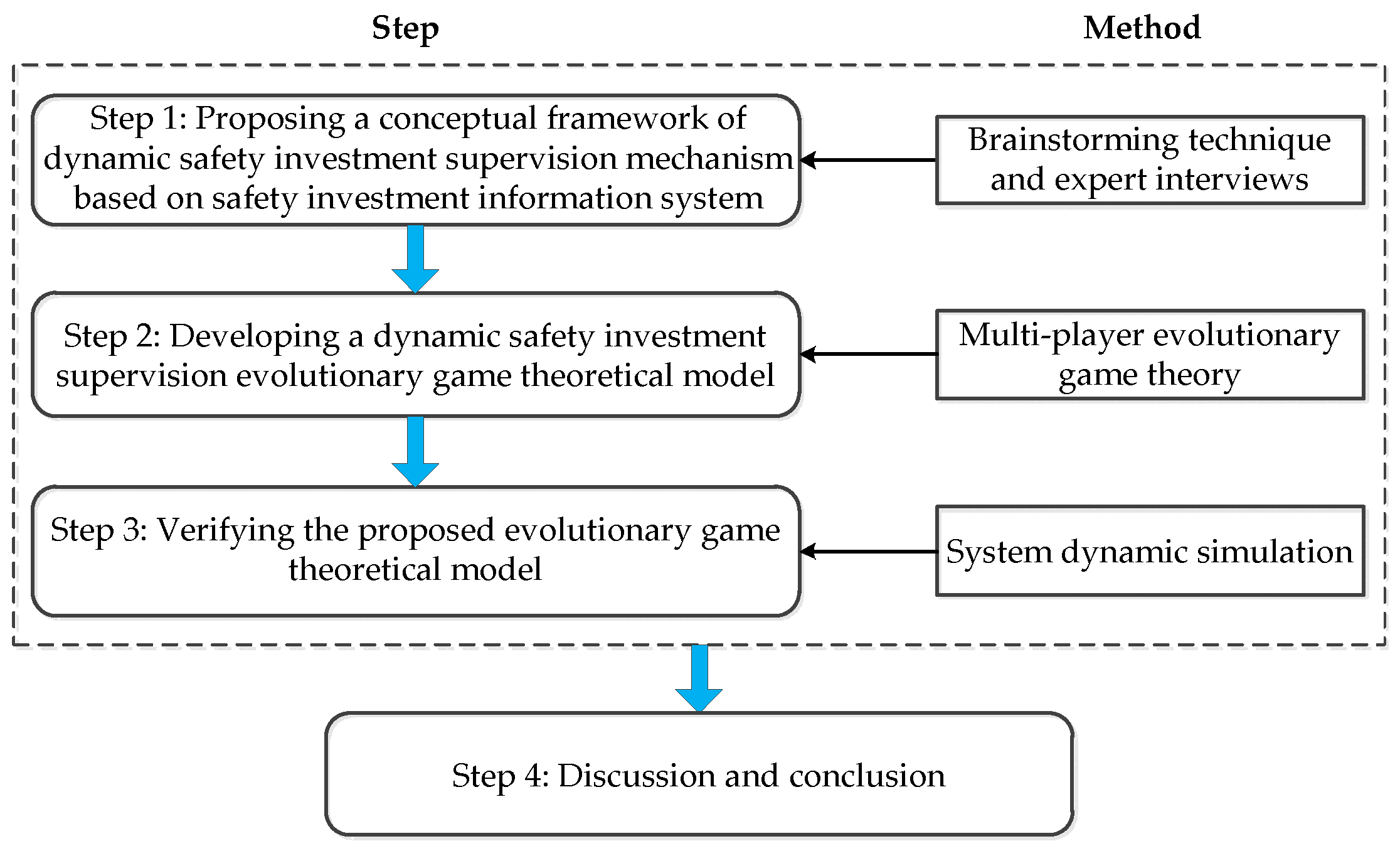
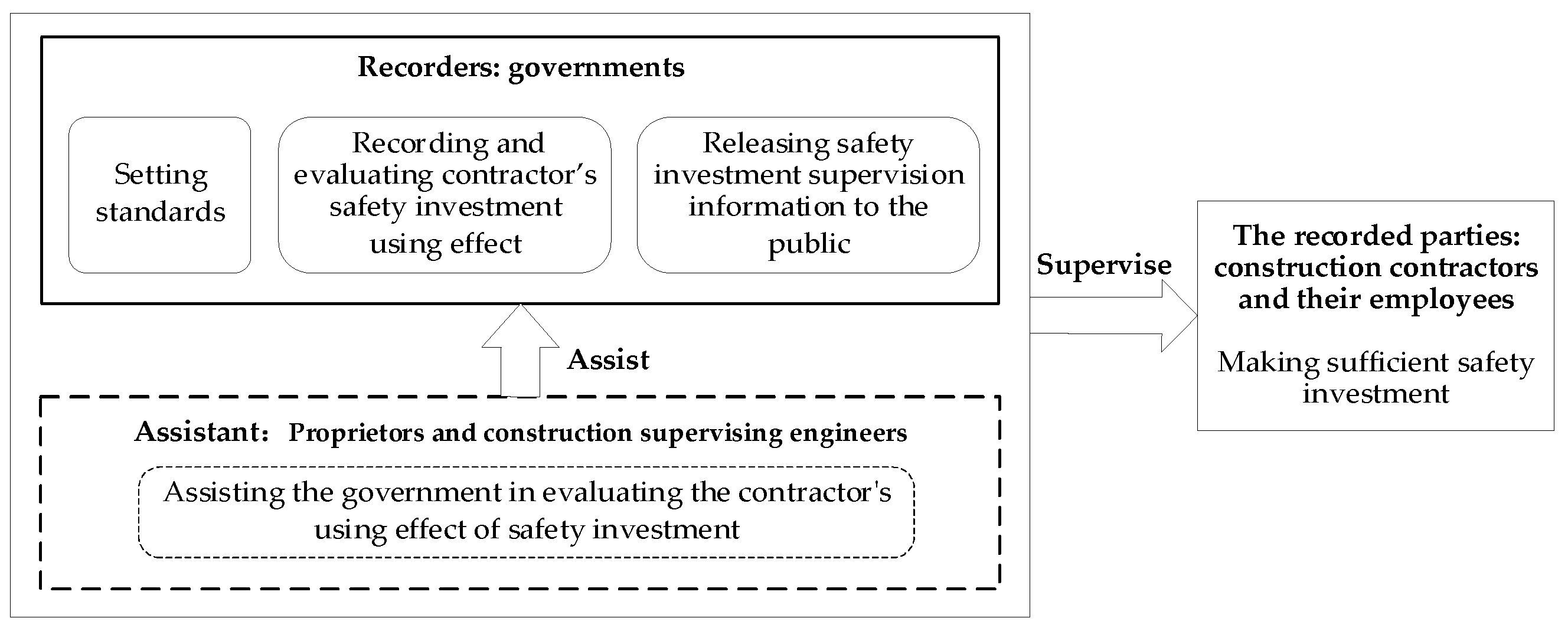
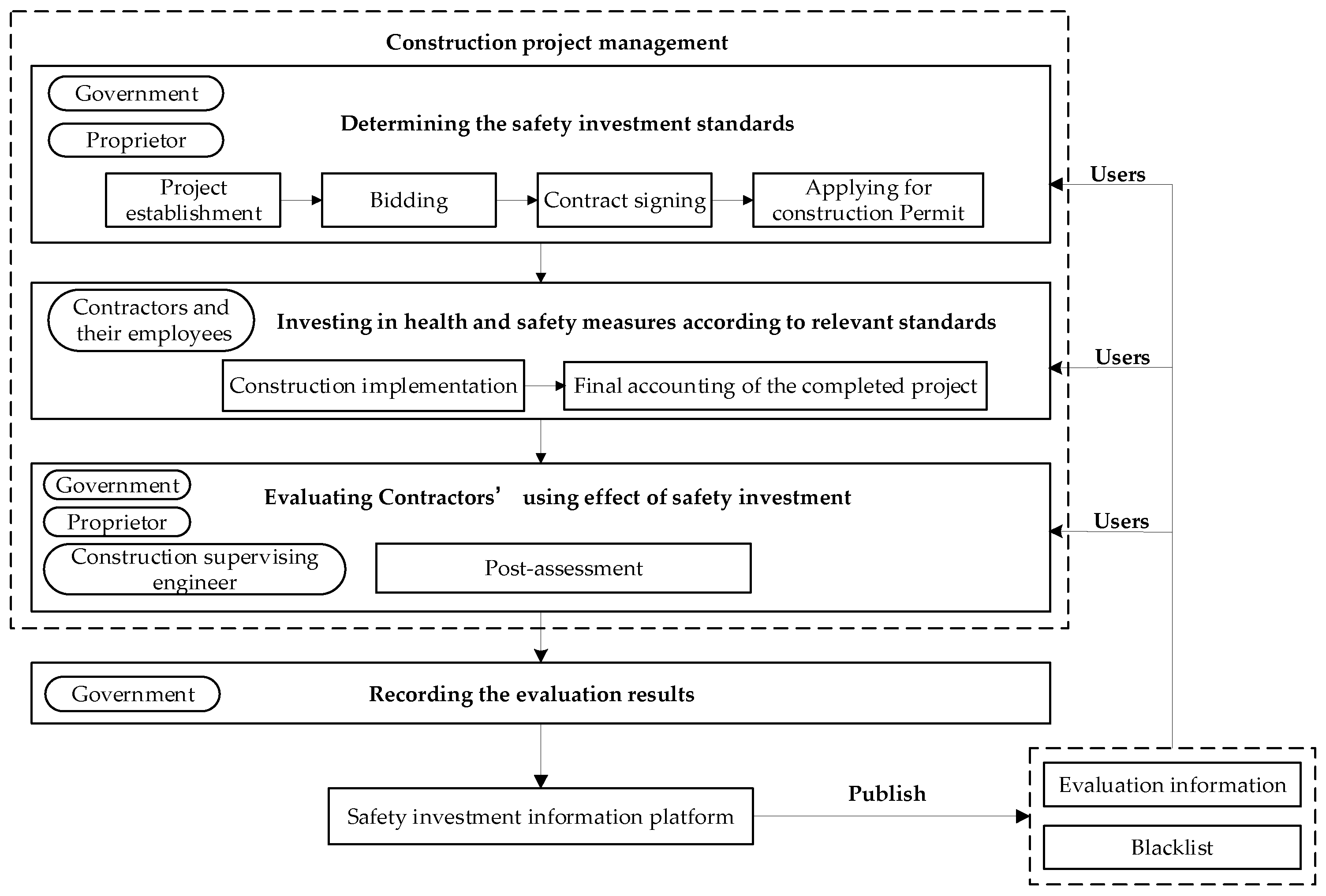

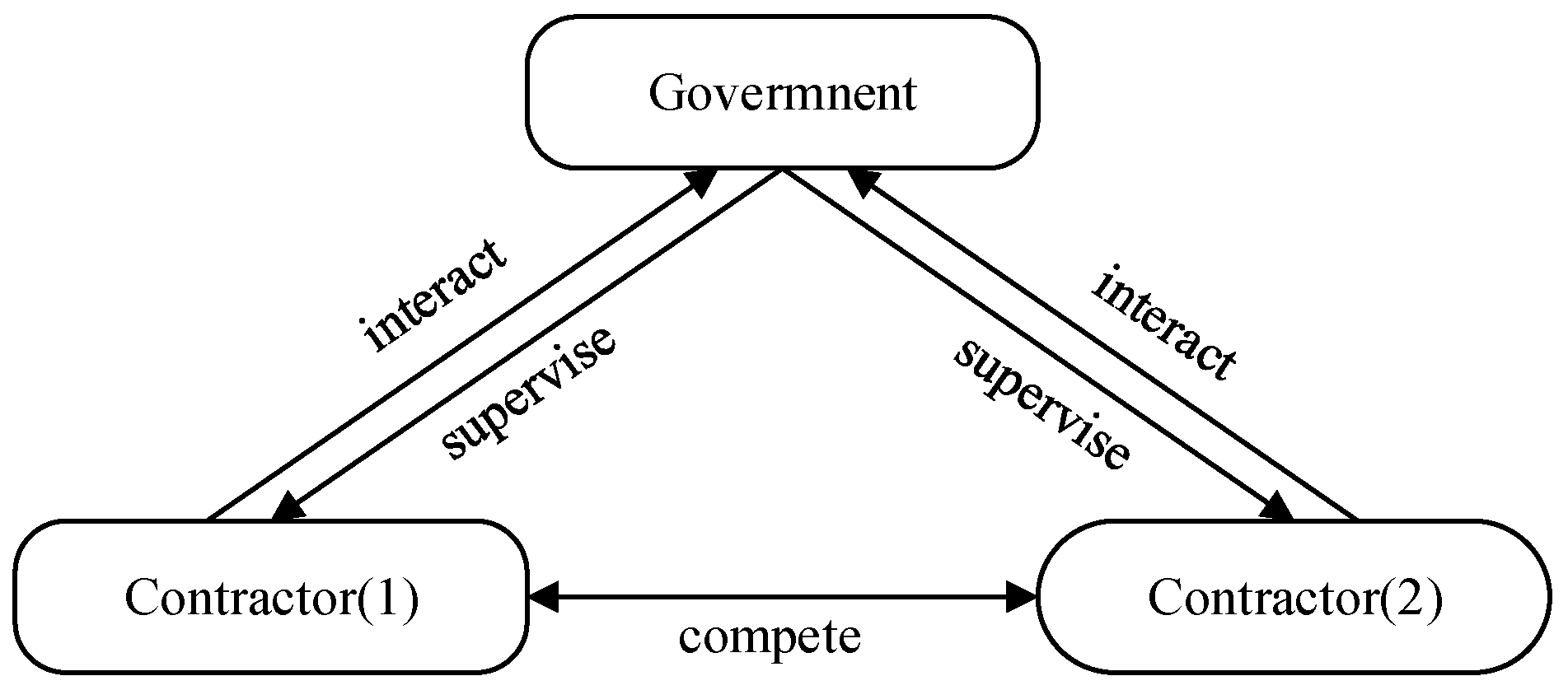
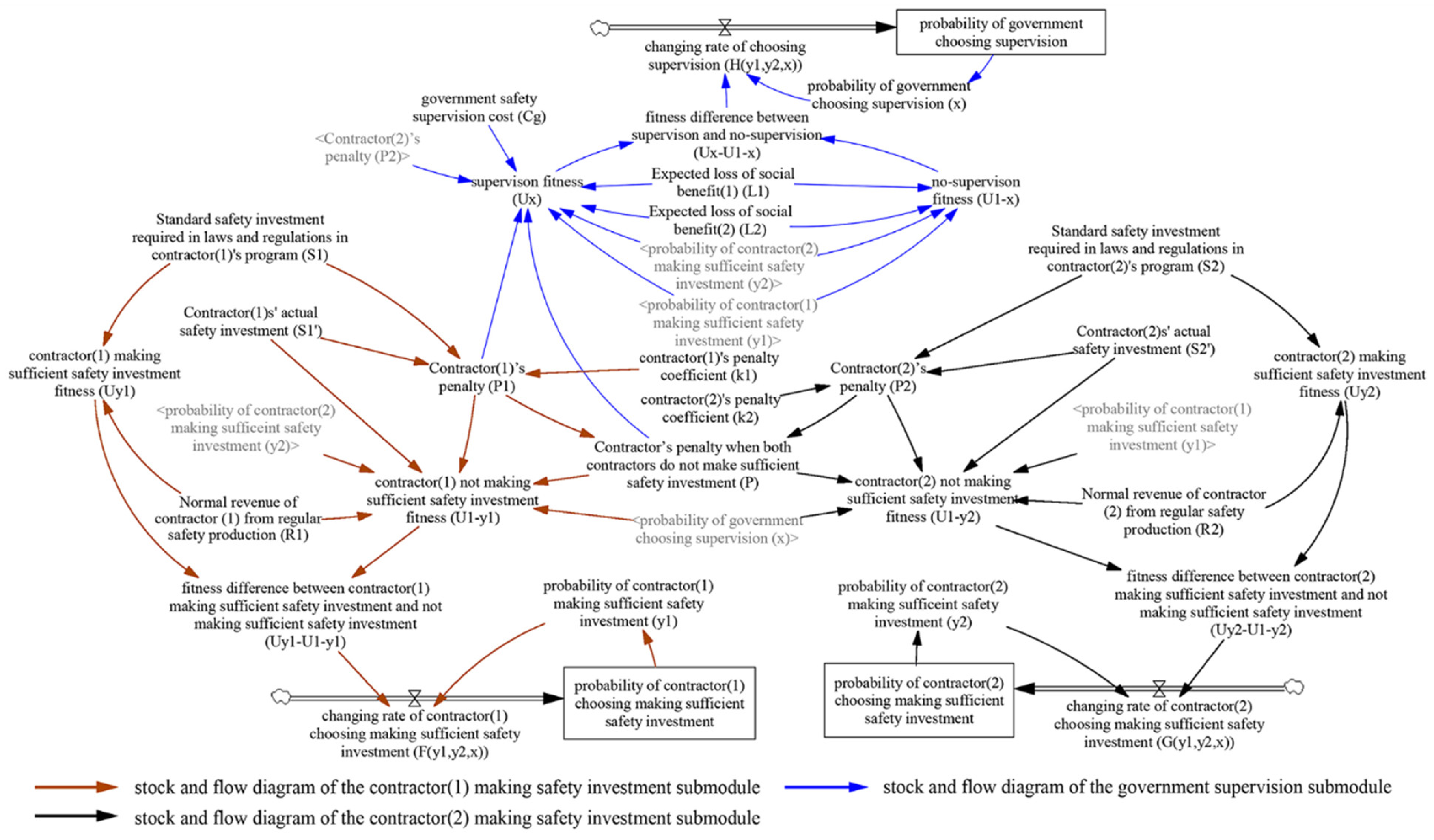
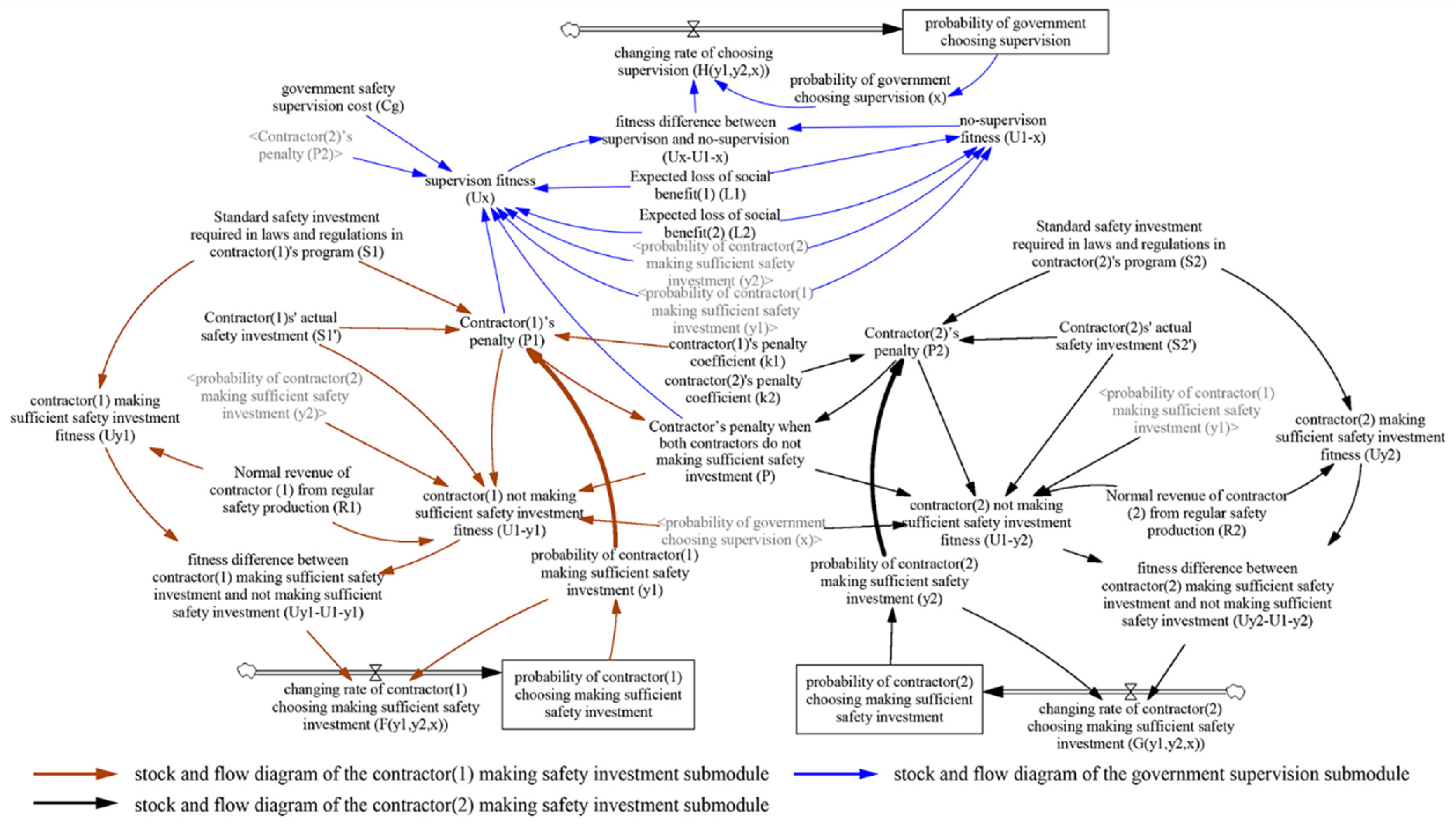
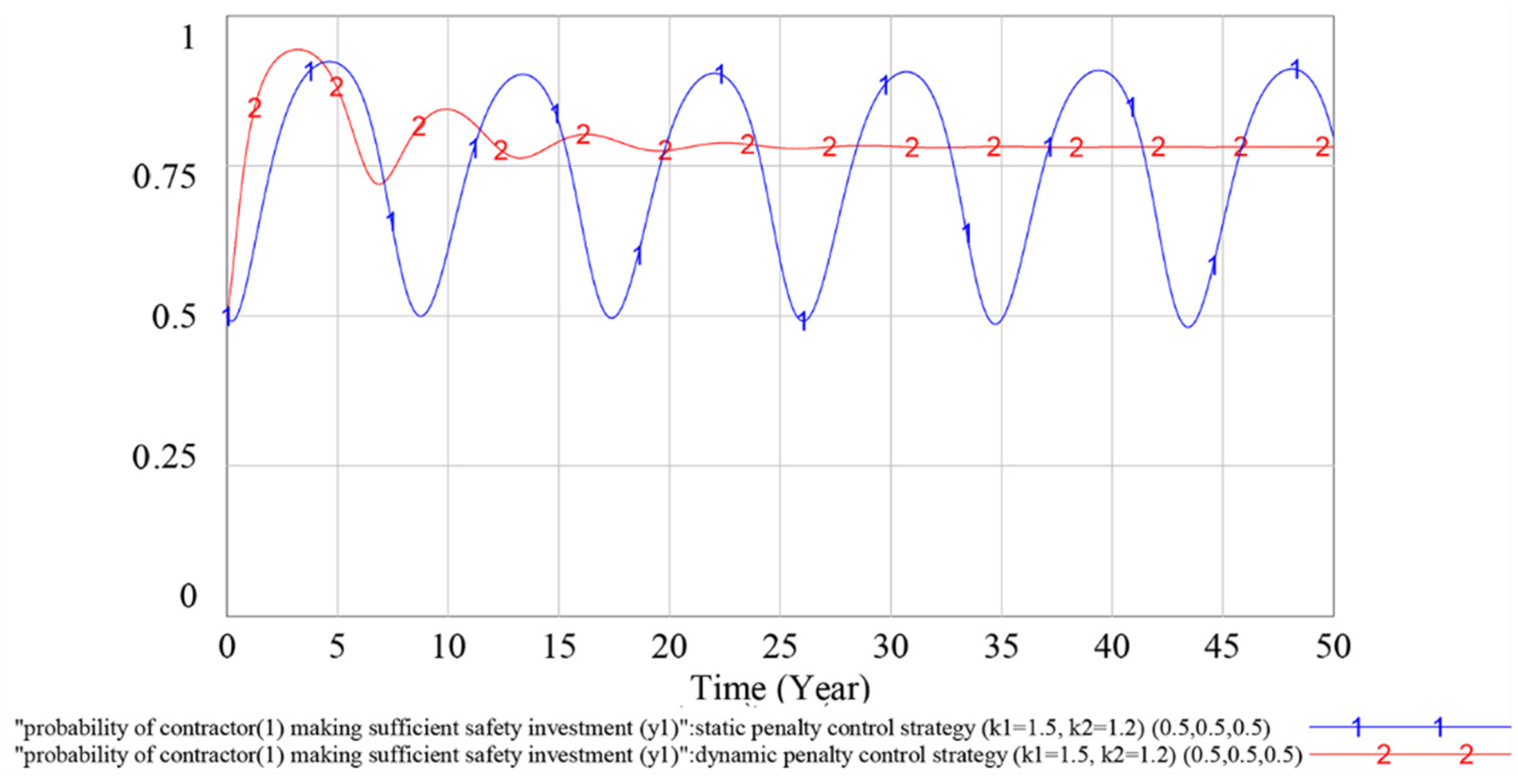

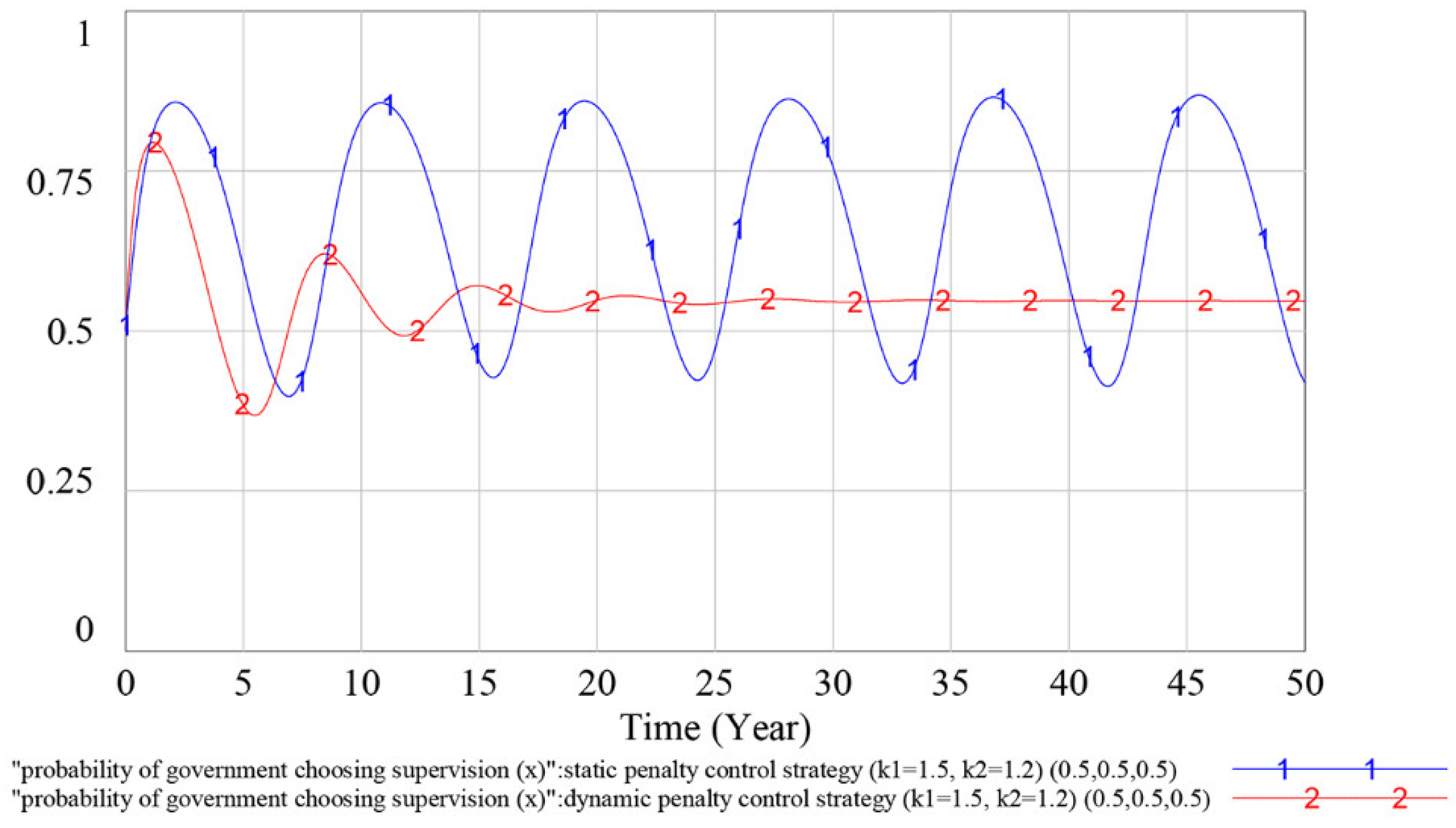

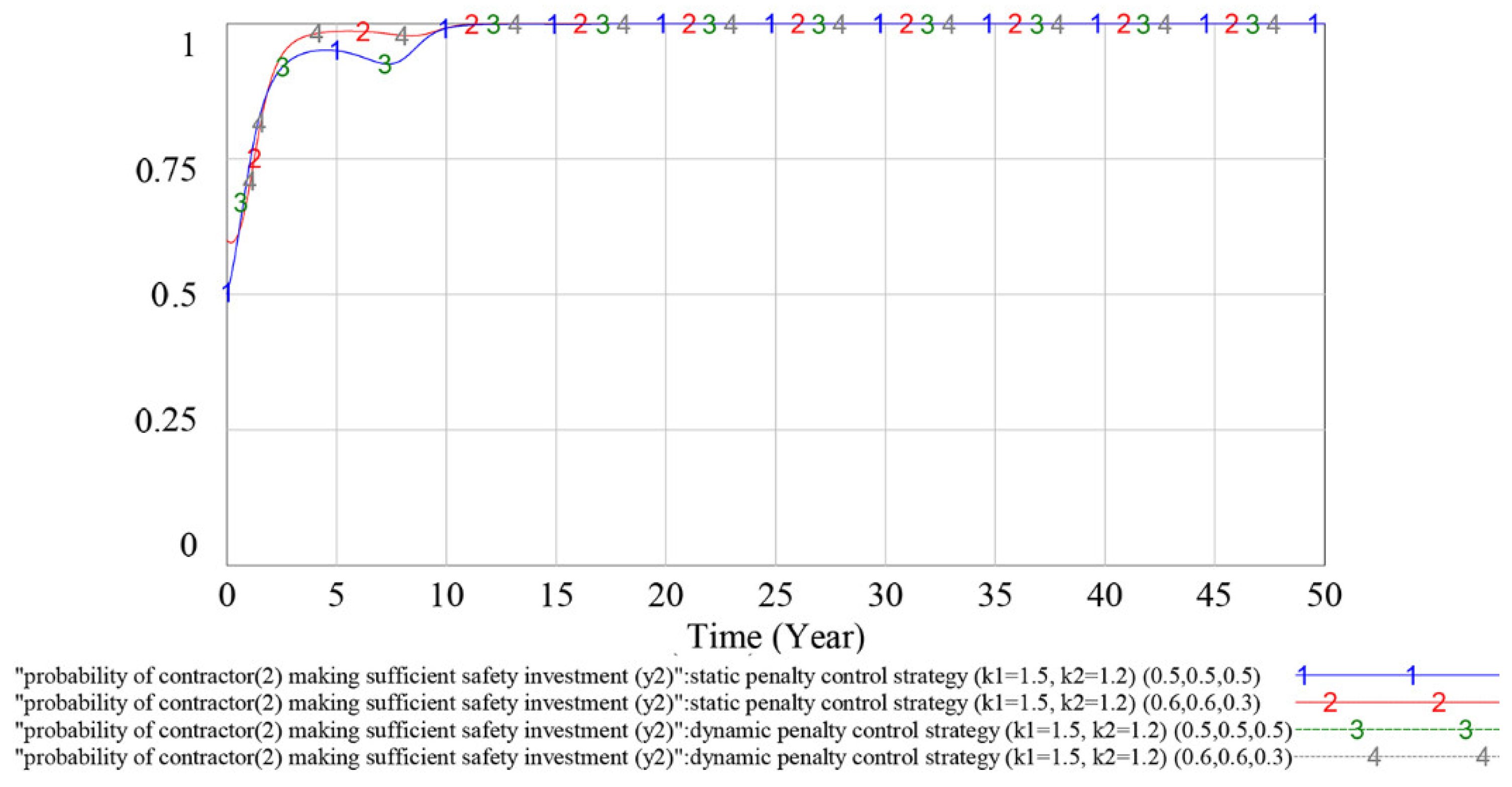
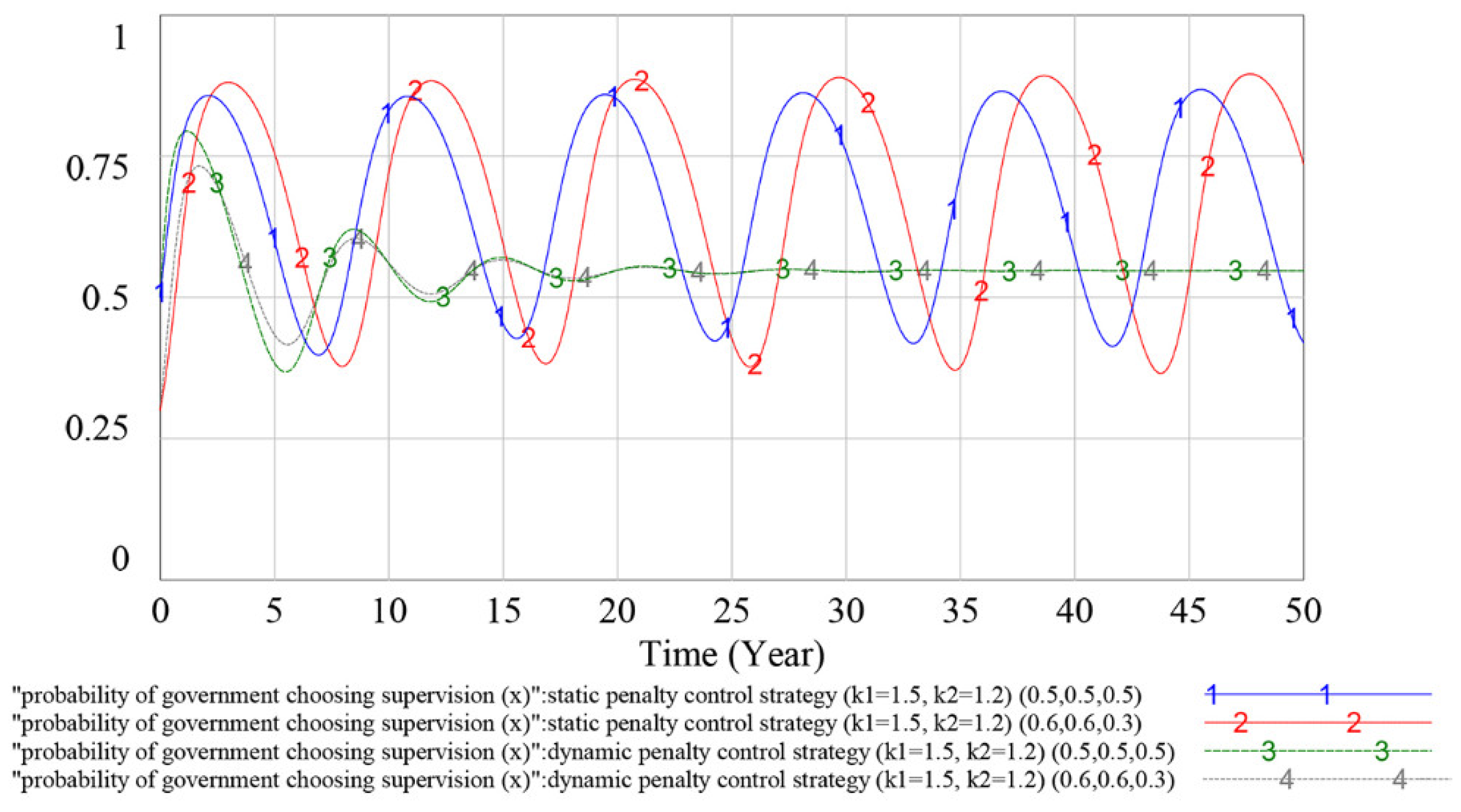
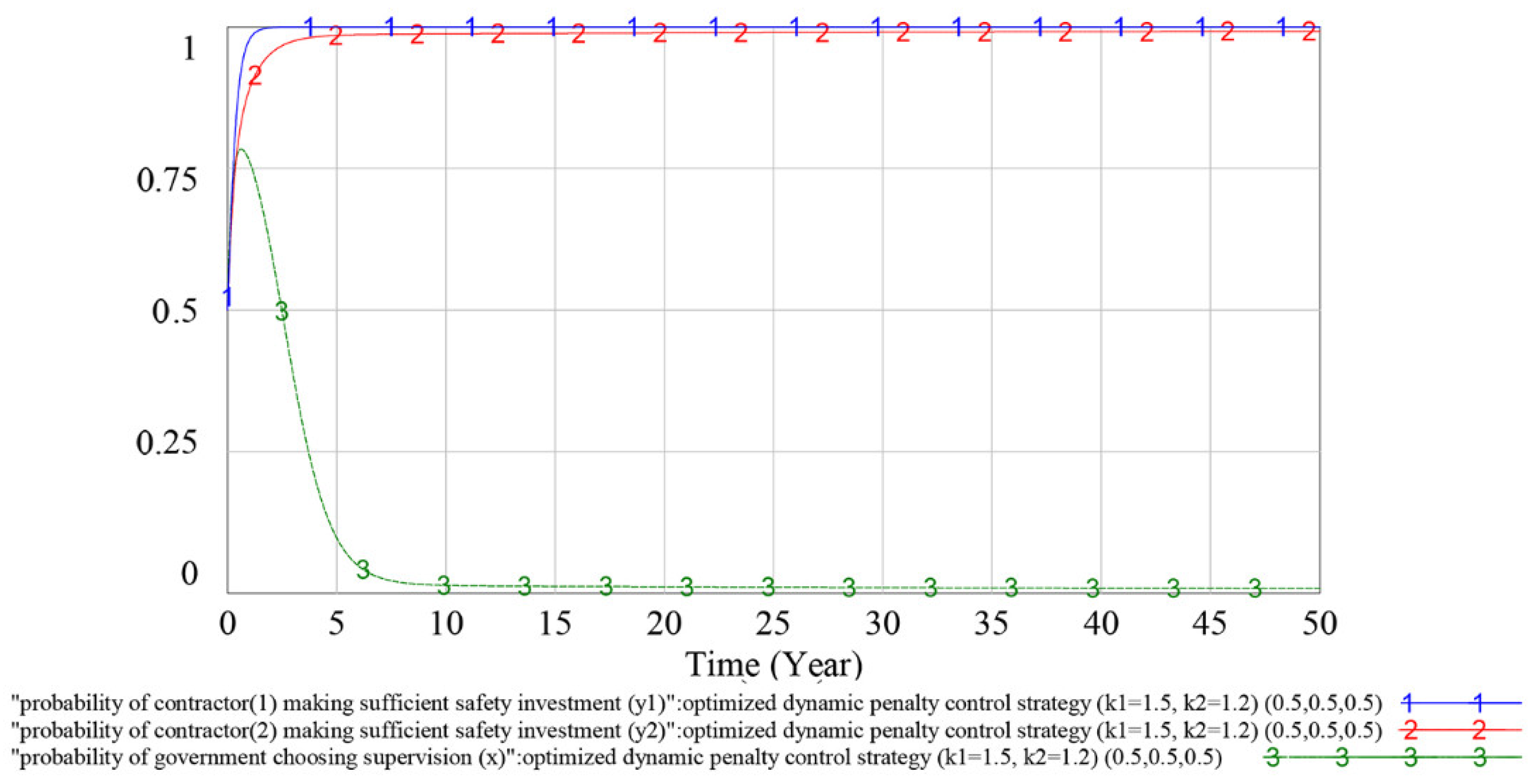
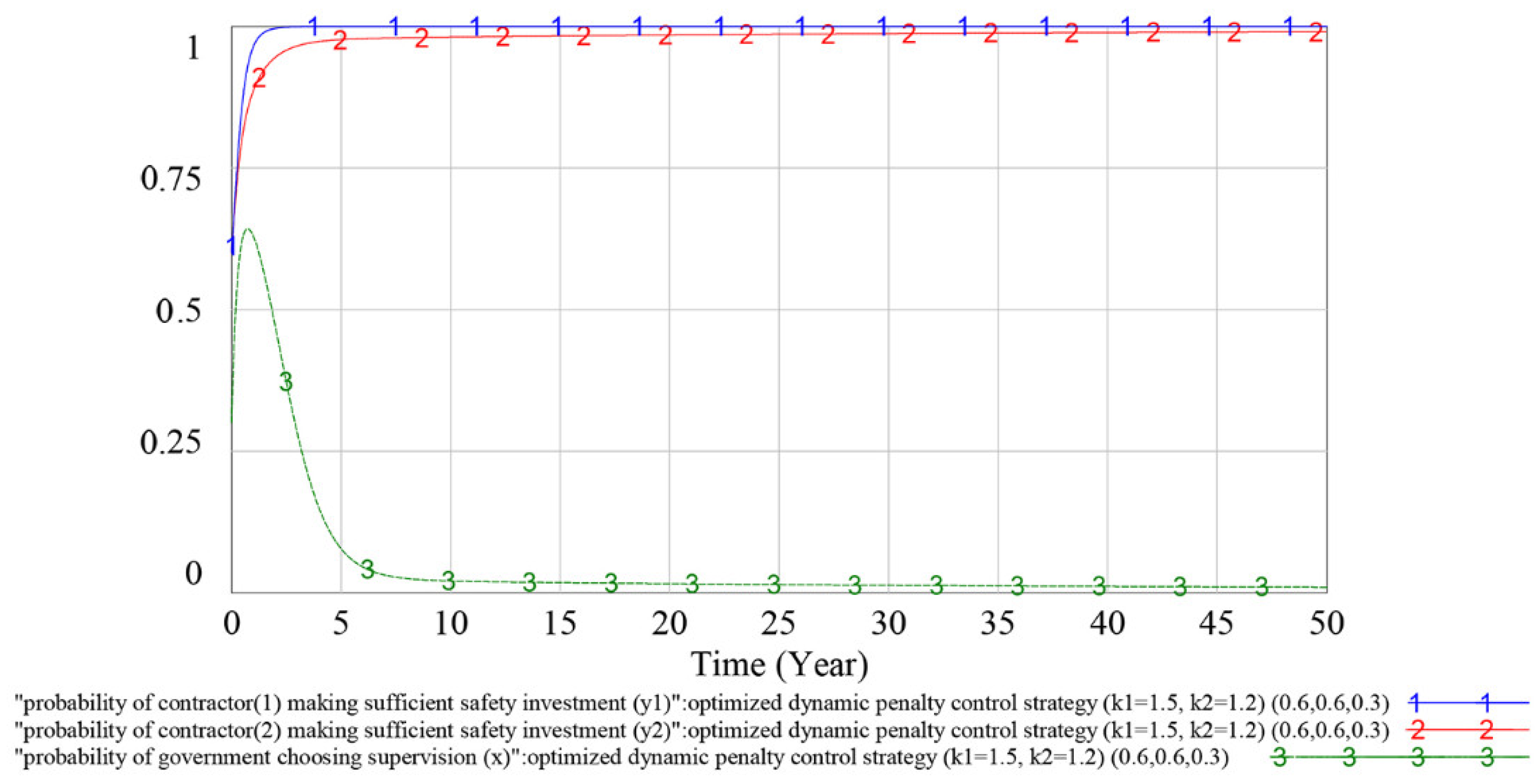
| Symbols | Description of Symbols | Notes |
|---|---|---|
| x | Probability of government supervision | 0 ≤ x ≤ 1 |
| y1 | Probability of contractor (1) making sufficient safety investment | 0 ≤ y1 ≤ 1 |
| y2 | Probability of contractor (2) making sufficient safety investment | 0 ≤ y2 ≤ 1 |
| Cg | Cost of safety supervision to the government | Cg > 0 |
| Ri | Normal revenue from regular safety production | Ri > 0, i = 1, 2 |
| Si | Standard safety investment required in laws and regulations | Si > 0, i = 1, 2 |
| Si’ | Contractors’ actual safety investment | Si’ > 0, i = 1, 2 |
| Li | Expected loss of overall social benefit as a result of insufficient safety investment | Li > 0, i = 1, 2 |
| Pi | Contractor’s penalty when only one contractor does not make sufficient safety investment | Pi > 0, i = 1, 2 |
| P | Contractor’s penalty when two contractors do not make sufficient safety investment | P > 0 |
| ki | Penalty coefficient | 1.2 ≤ ki ≤ 1.5 1, i = 1, 2 |
| Strategy of Contractor (1) | Strategy of Contractor (2) | |
|---|---|---|
| Making Sufficient Safety Investment (y2) | Not Making Sufficient Safety Investment (1 − y2) | |
| Making sufficient safety investment (y1) | ||
| Not making sufficient safety investment (1 − y1) | ||
| Strategy of Contractor | Payoff of Government | |
|---|---|---|
| Supervise (x) | Not Supervise (1 − x) | |
| Contractor (1) makes sufficient safety investment and contractor (2) makes sufficient safety investment, (y1, y2) | −Cg | 0 |
| Contractor (1) makes sufficient safety investment and contractor (2) does not make sufficient safety investment, (y1, 1 − y2) | −L2 | |
| Contractor (1) does not make sufficient safety investment and contractor (2) makes sufficient safety investment, (1 − y1, y2) | −L1 | |
| Contractor (1) does not make sufficient safety investment and contractor (2) does not make sufficient safety investment, (1 − y1, 1 − y2) | −L1 − L2 | |
| Symbols | Cg | R1 | R2 | S1 | S2 | S1′ | S2′ | L1 | L2 | K1 | K2 |
|---|---|---|---|---|---|---|---|---|---|---|---|
| Initial values | 1 | 40 | 30 | 15 | 15 | 12.5 | 14 | 3 | 1.2 | 1.5 | 1.2 |
Publisher’s Note: MDPI stays neutral with regard to jurisdictional claims in published maps and institutional affiliations. |
© 2021 by the authors. Licensee MDPI, Basel, Switzerland. This article is an open access article distributed under the terms and conditions of the Creative Commons Attribution (CC BY) license (https://creativecommons.org/licenses/by/4.0/).
Share and Cite
Gong, S.; Gao, X.; Li, Z.; Chen, L. Developing a Dynamic Supervision Mechanism to Improve Construction Safety Investment Supervision Efficiency in China: Theoretical Simulation of Evolutionary Game Process. Int. J. Environ. Res. Public Health 2021, 18, 3594. https://doi.org/10.3390/ijerph18073594
Gong S, Gao X, Li Z, Chen L. Developing a Dynamic Supervision Mechanism to Improve Construction Safety Investment Supervision Efficiency in China: Theoretical Simulation of Evolutionary Game Process. International Journal of Environmental Research and Public Health. 2021; 18(7):3594. https://doi.org/10.3390/ijerph18073594
Chicago/Turabian StyleGong, Shitao, Xin Gao, Zhou Li, and Linyan Chen. 2021. "Developing a Dynamic Supervision Mechanism to Improve Construction Safety Investment Supervision Efficiency in China: Theoretical Simulation of Evolutionary Game Process" International Journal of Environmental Research and Public Health 18, no. 7: 3594. https://doi.org/10.3390/ijerph18073594
APA StyleGong, S., Gao, X., Li, Z., & Chen, L. (2021). Developing a Dynamic Supervision Mechanism to Improve Construction Safety Investment Supervision Efficiency in China: Theoretical Simulation of Evolutionary Game Process. International Journal of Environmental Research and Public Health, 18(7), 3594. https://doi.org/10.3390/ijerph18073594






